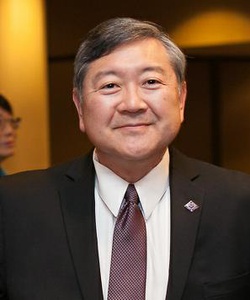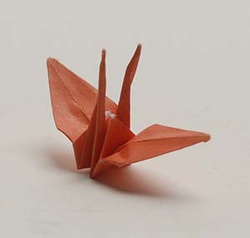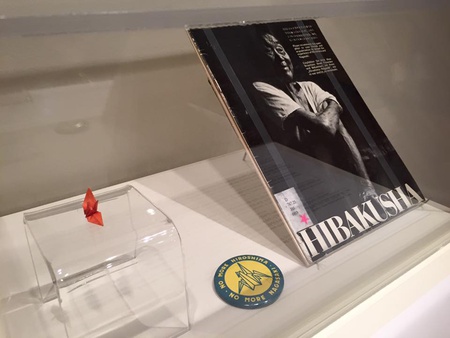Japanese War Movie Making Paper Cranes Origami

http://www.discovernikkei.org/en/journal/2016/7/5/paper-and-peace/
Paper and Peace: Seeing Hiroshima's Origami Cranes Through Japanese American Eyes
"I always like to tell my friends that every little thing in Japanese culture has some symbolism and meaning," Richard Watanabe says.

Richard Watanabe
The 15-year volunteer at the Japanese American National Museum (JANM) in Los Angeles recently returned from a trip to Hiroshima, Japan. The site of the fateful atomic bombing during World War II has become known internationally for its origami cranes symbolizing peace.
Watanabe, who by day is a Professor of Preventive Medicine and Physiology & Biophysics at the Keck USC School of Medicine, had been in Japan for a human genetics conference, and took time out to revisit places of his family heritage around Hiroshima, as well as other areas of the country.
"Ancestors on both sides of my family are from Hiroshima," Watanabe explains. "I'm a Yonsei [fourth-generation Japanese American]. My paternal great-grandfather immigrated to the U.S. during the Kanyaku Imin [influx of government contract workers starting in the late-1800s] period. My paternal grandfather moved the family back to Hiroshima when my father was very little and my father did not return to the US until the early 1950s. My mother is a Japanese national, whose family is from Hiroshima."
"I used this opportunity to do ohaka-mairi [paying respects to deceased relatives] and visit family," Watanabe says. "One of the days in Hiroshima was used to do a day trip to Iwakuni to visit Kintaikyo and Iwakuni-jo. I've been to Hiroshima many times, but the last time I was there was about 10 years ago, so this trip was very natsukashii [fondly nostalgic] for me."
The trip proved timely and meaningful. Soon after Watanabe's visit, in May 2016, U.S. President Barack Obama became the first serving American president to visit Hiroshima and delivered a major address about international peace and the tragic legacy of nuclear war.
Obama also visited a memorial display for Sadako Sasaki, the subject of the well-known children's book, Sadako and the Thousand Paper Cranes. Sasaki was a child in Hiroshima who developed leukemia as a result of exposure to radiation from the atomic bomb. During her hospitalization, Sasaki began folding origami cranes in hopes that it would bring her good luck and health. According to Japanese legend, people who fold one thousand cranes are granted a special wish. Sasaki died in 1955, and her story later inspired a permanent monument that continues to receive thousands of paper cranes in the present day. The president's visit received worldwide media coverage and brought Hiroshima—and its origami cranes—into a renewed spotlight.

In the same month, members of Sadako Sasaki's family donated an original origami crane folded by Sasaki to JANM, where Watanabe volunteers. JANM is the only site on the American West Coast to receive one of Sasaki's cranes, and one of only a handful of recipients around the world.
For Watanabe, the donated crane is meaningful, both historically and personally. "The Sadako cranes represent and convey so many things," he says. "For me, the most important thing they convey is for people to remember the price of war, especially in modern times where so-called smart weapons have sanitized war to a level unprecedented since that fateful day in 1945. Here is a young girl, an innocent victim of a war, facing the horrors of a new weapon, and holding to Japanese traditions to help her through her ordeal."
"I guess the other important thing from my perspective is the appreciation and preservation of Japanese traditions," he adds. "I would hope that future generations understand and appreciate the hopes Sadako placed on the tradition of folding tsuru [cranes]."
"The thousand cranes themselves are a great reminder of an important Japanese tradition, one that is easy to remember and pass on to the next generation," Watanabe says. "Sadako's story is also a great reminder to future generations about the tragedy of war. When one thinks of the millions of cranes that have been folded in memory of Sadako and her story, those cranes build a physical link between August 6, 1945, Sadako, and the current generation."
In his speech, Obama echoed the desire to ensure that the past is not forgotten by the current and future generations. "Those who died—they are like us. Ordinary people understand this, I think. They do not want more war. They would rather that the wonders of science be focused on improving life, and not eliminating it. When the choices made by nations, when the choices made by leaders reflect this simple wisdom, then the lesson of Hiroshima is done."

Sadako Sasaki's origami crane is now on display, donated to JANM by her family with a hope for peace.
*The donated crane folded by Sadako Sasaki is now on view at the Japanese American National Museum. On August 6, 2016, Above the Fold: New Expressions in Origami curator Meher McArthur will give a talk about Sasaki and her cranes at JANM. Click here for details and to RSVP for the program.
* Discover Nikkei is a project of the Japanese American National Museum, made possible through the generous support of The Nippon Foundation
Japanese War Movie Making Paper Cranes Origami
Source: http://www.discovernikkei.org/en/journal/2016/7/5/paper-and-peace/
0 Response to "Japanese War Movie Making Paper Cranes Origami"
Post a Comment